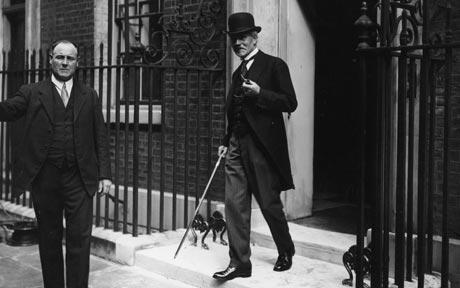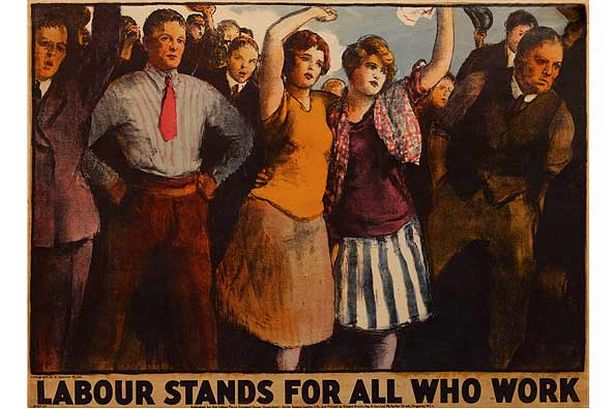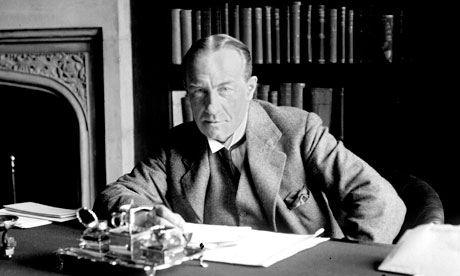by Pete Goddard and Atul Hatwal
Parliament dissolved on October 7th 1931 in preparation for an election on the 27th.
It was hard to believe the national government had been formed just six weeks earlier. At that time, Ramsay Macdonald had promised his shocked Labour colleagues that there would be no coupons or pacts when the election came.
Now he slowly opened up his card to reveal… “Bluff.”
The national government resolved to stand as a single unit. Expelled from the Labour party, Macdonald, Philip Snowden, Jimmy Thomas and the other Labour defectors readied themselves for a contest where they would fight the colleagues they had once worked so hard to support.
Alongside them were the other members of the polyglot coalition. This national government had determined to go into the election asking for a “doctor’s mandate,” a request to be given a free hand to deal with the nation’s ills as they saw fit.
As a pitch, there were some obvious flaws.
The first was that the one significant prescription this national government had offered during the currency crisis, to try to stay on the gold standard at all costs, had proved catastrophically wrong.
But worse, now the gold standard had been abandoned, on the question of the economy, the three squabbling parties could not agree on the nation’s illness, let alone the cure.
The Conservatives were convinced that this was finally the moment for protection. Of course, they had been thinking ‘this is finally the moment for protection’ continuously since 1906. Like the proverbial man with only a hammer, regardless of the problem, the Tory solution had been to abandon free trade and raise tariffs on imports. But this time they were really, really sure it was the answer.
Elsewhere in the coalition, the Liberals were equally convinced that now, more than ever, but also kind of exactly like all those times before, free trade was needed. They only had a screwdriver.
In between the Tories and Liberals were Ramsay Macdonald and his ex-Labour team. They had reconstituted themselves as the optimistically titled National Labour – curiously and coincidentally the same name as George Barnes’ ill-fated version of Labour that had fought as part of Lloyd George’s Tory dominated coalition in 1918
Macdonald didn’t have any tools at all. He leant towards the Tories on protection but not to the point where it was worth losing the Liberals from the coalition.
More than anything else, a Liberal-less government would make Macdonald an even bigger prisoner of the Tory majority. Sure, he’d still be a prisoner if the Liberals stayed, but it was better to be in the exercise yard with a few mates than stuck in solitary.
After days of drawn-out negotiations at the end of September, involving Macdonald yet again deciding to resign only to be convinced to stay on as PM, the government had finally resolved on a mutually acceptable formula.
They would agree to disagree.
At the impeding election, each party in the government would issue their own, contradictory manifesto. This division was to be papered over with a joint call to the public from the parties for the doctor’s mandate along with a heavy dose of “look over there at Labour, they’re rubbish.”
As the campaign got underway, the national government parties tore into Labour. It was portrayed as lacking political control (hard to rebut given, their government had fallen apart) a party of squanderers (harsh) and a band of mad socialists preparing to steal the deposits in the Post Office Savings Bank to pay the deficit (an outright lie).
The contest was defined for the public by sight of former comrades on the left attacking one another in the strongest terms.
Former ILP member and one-time left-wing firebrand, Philip Snowden led the way. As he wrote candidly after the election, “Every day from the first day of the election campaign to the eve of the poll I launched attacks on my late Labour colleagues.”
Snowden described the Labour manifesto as “Bolshevism run mad” and added, “the issue of this election is between prosperity and ruin.”
Hard to believe he had been one of them less than two months previously.
Macdonald refrained from attacking his former comrades but wasn’t above smearing Labour.
His stump speech included dire warnings on the threat of hyper-inflation if Labour gained power. Speaking on the 19th October, Macdonald illustrated his charge by flourishing a German note worth 50m marks.
Nominally worth £250,000, it could have been bought for two shillings during the German financial collapse, although if you bought enough of them they did come with a free wheelbarrow.
In return, Labour’s argument went:
“We oppose the cuts, and will nationalise banking, iron, steel, power and transport”
Electoral incredulity at Labour rejecting the very cuts it had itself devised combined with with fears over mass nationalisation and the general lack of credibility following the fall of the last Labour government left the party doomed.
Labour’s leaders knew they were onto a loser. But no party can admit as much to itself and still carry on. So they clung to the hope that the unpopularity of the cuts meant that people would plump for them as the new anti-cuts party.
These hopes were given succour by varied reports of high canvass returns and the reception many Labour politicians were receiving on the campaign trail.
On the eve of the election, the Guardian published a prediction by “an expert electioneer properly so called” which had Labour on 215 seats and the Tories on 316 seats.
Well, if an expert has predicted it, what could possibly go wrong?
Labour’s leaders crossed their fingers, toes and just about anything they could. Unfortunately, at the same time, voters were crossing their ballot papers. And not for Labour.
The result was the biggest landslide in British electoral history.
Labour lost 2 million votes, In terms of seats it was even worse. Labour had 289 MPs before, and just 46 after.
There were also 5 Independent Labour Party MPs who had run independently who might help out in a pinch. But it would hardly make a difference.
The national government parties had 554 seats, with Tories in the ascendant holding 471 seats, up from 260.
The Liberals appeared to have done well, taking 72 seats, up from the 59 before. But underneath this they were still riven with infighting, outdoing the Labour party by splitting into three bitterly opposed factions – 33 Liberal free traders under Herbert Samuel, 35 Liberals prepared to countenance some protection under Sir John Simon and another 4 consisting of Lloyd George and close family.
The Samuelites and Simonites were part of the national government with Lloyd George refusing to join.
As for Mosely’s New Party, which stood in 24 seats, they won absolutely nothing. Ha!
The predicament of the Liberals, and Mosely’s electoral demise were small consolations for Labour though. The party had not just diminished in size, it had experienced the complete destruction of its leadership.
Of the Labour cabinet, only George Lansbury held his seat. Everyone else, including Arthur Henderson had been wiped out. And to make matters worse, somehow, despite all expectations, Ramsay Macdonald had held on to the once safe Labour seat of Seaham.
Headless, damaged and demoralised, it was a new low for the Labour party.
How could they recover from this?
Pete and Atul are not historians
Tags: 1922, Aul Hatwal, election, Labour history uncut, Pete Goddard, Ramsay Macdonald












What a catastrophe! A complete meltdown!
‘Electoral incredulity at Labour rejecting the very cuts it had itself devised… etc’. Heard that one before! It’ll probably take a War to recover, I think, and a reliance on peoples short term memory.
A more relevant question would be “When will Labour actually die”?
My bets would be on the first half of 2014 with the aftermath of the Special Conference or The May Elections as the most likely crisis points.
In the highly unlikely event of Labour expiring in 2014 one wonders how Paul Barker will fill his days without being able to post anti Labour rants, mostly on Lib Dem Voice? He ought to be careful what he wishes for. His obsession with the demise of Labour seems rather lacking in a sense of proportion. I expect that, as usual, Labour will muddle through somehow, despite itself.
I would be extremely surprised if the performance of Labour in the 2014 European and local elections didn’t surpass that of the Lib Dems, Browsing the comments on LDV underneath the story about Sarah Teather not running in 2015, it struck me how much hatred some Lib Dems seem to have for their fellow party members. Perhaps it is time once more, like in the 1930s for the Lib Dems to fracture into two or three groups.